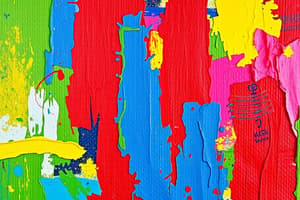Podcast
Questions and Answers
What is the primary purpose of texture mapping in 3D graphics?
What is the primary purpose of texture mapping in 3D graphics?
- To reduce rendering time
- To increase geometric complexity
- To eliminate the need for lighting
- To enhance visual detail and realism (correct)
Bump mapping changes the actual geometry of a 3D model.
Bump mapping changes the actual geometry of a 3D model.
False (B)
What do the U and V coordinates represent in texture mapping?
What do the U and V coordinates represent in texture mapping?
Texture coordinates in a 2D texture space
____ mapping controls how light reflects off surfaces.
____ mapping controls how light reflects off surfaces.
Match the following types of texture mapping with their descriptions:
Match the following types of texture mapping with their descriptions:
Which texture mapping technique uses pre-calculated textures to improve rendering efficiency?
Which texture mapping technique uses pre-calculated textures to improve rendering efficiency?
Texture resolution has no impact on the visual quality of a 3D model.
Texture resolution has no impact on the visual quality of a 3D model.
Name one application of texture mapping in the real world.
Name one application of texture mapping in the real world.
Efficient UV mapping is crucial to minimize ____ and seams.
Efficient UV mapping is crucial to minimize ____ and seams.
What is the effect of trilinear filtering in texture mapping?
What is the effect of trilinear filtering in texture mapping?
Flashcards are hidden until you start studying
Study Notes
Detail: Texture Mapping
-
Definition
- Texture mapping is a method used in 3D computer graphics to apply an image (texture) onto the surface of a shape.
-
Purpose
- Enhances the visual detail and realism of 3D models without increasing the geometric complexity.
- Helps simulate surface properties like color, patterns, and materials.
-
Components
-
Texture Coordinates (UV Mapping)
- Each point on the 3D model is assigned a coordinate in a 2D texture space (U, V).
- Determines how the texture is applied to the model.
-
Textures
- Images or patterns used to cover the 3D model.
- Can be diffuse (color), specular (shine), normal maps (bumpiness), etc.
-
-
Types of Texture Mapping
-
Diffuse Mapping
- Basic color and pattern application.
-
Bump Mapping
- Simulates surface detail by altering surface normals without changing the model's geometry.
-
Normal Mapping
- Uses a texture to create the illusion of complex surface detail by changing how light interacts with the surface.
-
Specular Mapping
- Controls shininess and reflectiveness; specifies how light reflects off surfaces.
-
Displacement Mapping
- Alters the actual geometry of the surface based on the texture, creating more realistic details.
-
-
Techniques
-
Trilinear Filtering
- Smooths textures when viewed from different distances and angles.
-
Mipmapping
- Uses pre-calculated textures at various levels of detail to improve rendering efficiency and reduce artifacts.
-
-
Applications
- Video games, simulations, and visual effects in film.
- Architectural visualization and product design.
-
Considerations
- Texture resolution affects visual quality; higher resolutions yield better detail but require more memory.
- Efficient UV mapping is crucial to minimize texture stretching and seams.
Texture Mapping Overview
- Texture mapping applies images to 3D shapes to enhance realism without increasing geometric complexity.
- It simulates surface properties such as color, patterns, and materials.
Key Components
- Texture Coordinates (UV Mapping)
- Each vertex on a 3D model is linked to a 2D texture space, crucial for texture application.
- Textures
- Constitute images or patterns, including diffuse (color), specular (shine), and normal maps (bumpiness).
Types of Texture Mapping
- Diffuse Mapping
- Basic method for applying colors and patterns.
- Bump Mapping
- Enhances surface detail by modifying normals, leaving the model's geometry unchanged.
- Normal Mapping
- Utilizes textures to simulate complex details by altering light interactions on the surface.
- Specular Mapping
- Determines the shininess and reflectiveness of surfaces by controlling light reflection.
- Displacement Mapping
- Changes the actual surface geometry based on texture details, adding realism.
Techniques in Texture Mapping
- Trilinear Filtering
- Provides smooth texture appearance from varying distances and angles.
- Mipmapping
- Employs pre-calculated textures at multiple detail levels for improved rendering and reduced artifacts.
Applications
- Widely used in video games, simulations, visual effects for films, and architectural visualization.
- Enhances product design presentations.
Considerations
- Texture resolution is critical: higher resolution improves detail but demands more memory.
- Efficient UV mapping is essential to prevent texture stretching and visible seams.
Studying That Suits You
Use AI to generate personalized quizzes and flashcards to suit your learning preferences.




